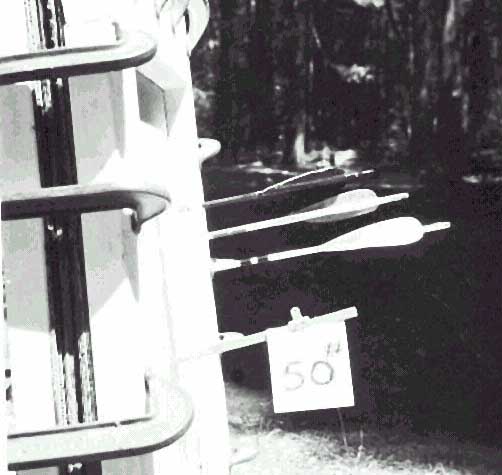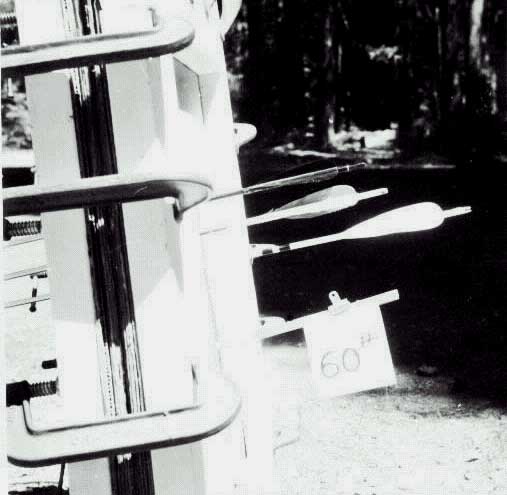A Penetrating Look At Penetration By Jack Howard
Discussion on arrow penetration brings to mind some tests I made on penetration many years ago. There always have been various opinions on which is best to use for hunting, a heavy arrow or a light one.
To my knowledge, there never really has been any actual test to come up with an answer. At least , I haven’t seen the results of any.
I guess most hunters base their ideas about arrow penetration either on their own personal experiences or that of one of their buddies. If a fellow happens to kill a deer with a light arrow that really zips out of his bow, he is sure he has the answer. If someone else really clobbers his game with his heavy arrows, he is just as positive he is on the right track.
I have seen many theories over the years based on formulae as to why a heavy arrow moving at a slower speed will penetrate farther than a light arrow moving at a faster speed. I also have seen about as many theories based on formulae that say just the opposite. I think I am right calling these formulae only theories, especially when they come up with different answers.
I made the aforementioned tests many years ago, but that was before fiberglass was being used in bows, which certainly could make a difference in the results. I have just made some new tests so I could have some pictures to show the results. The tests I made many years ago were for my own information, so I did not take any pictures at that time.
Before I go into the results I would like to tell a little about my test set up. To make any test worthwhile, you must use items that are constant as possible. For the material to shoot into I chose compressed cardboard. There are a number of things a person could use such as hay, straw, sand, meat, but I felt these were not consistent enough for a good test.
I can shoot six matched arrows into the cardboard and measure the distance from the face of the cardboard back to the nock and get consistent readings. By shooting an arrow twelve times into the cardboard, recording the penetration and dividing this figure by twelve, you get an accurate figure on just how far the arrow is penetrating.
As for the test points I used, I feel broadheads are not constant enough. In using broadheads for a test, the results could be misleading as the efficiency of the broadhead then would enter into the test. Penetration could be affected by the sharpness of the edge and type of head used.
Some broadhead’s points will cause the shaft to bind, while others will open a hole and there would be no shaft bind. I have done some tests using broadhead points and they are difficult to work with. You have to use thick cardboard, then chisel each head out after every shot. My main concern with this penetration test to get an accurate indication of the effect that weight has on penetration. The most consistent point I know of and the ones I used for the test were standard target points flush with the shaft. The shape and sharpness of these points are identical. By using a consistent material to shoot into and by using identical points, I feel the results of my test are as accurate as possible.

The bow weights I used for the test were 40, 50,and 60 pounds. The arrow weights were 325, 480 and 650 grains. These were Easton arrows and made especially for this test. The heavy arrow was made exactly twice as heavy as the light arrow. The medium weight arrow was made just about in the middle between the heavy and light arrow. The arrows were all exactly twenty six inches long. I had to make them this short, as it was the only way I could get enough spine on the light arrow to fly out of a sixty pound bow.

Out of a bow with a given weight, I think we all realize that, as arrow weight is increased, the speed of the arrow decreases, and as the arrow weight is decreased , the arrow speed increases. My test shows that an arrow on the lighter side rather than the heavy side has the advantage.
Does this mean you should all rush out and buy light arrows? By all means, no. It must be considered just how light you should go or just how heavy you should go. Tests also show that heavier bows penetrate farther than light bows and heavy bows require heavier arrows for proper flight. An arrow must not wobble or fly sideways, or it will lose considerable penetration.
As I have a great interest in hunting elk, I use heavy arrows, but I also use a heavy bow. I am sure you will find that the arrow perfectly matched for your bow will be a satisfactory hunting arrow. I personally prefer Easton arrows, because there are so many different sizes from which to choose that one can get an absolute perfect match.
Most of broadhead arrows are quite long and we have that extra weight right out at the tip with which to contend. We need a fairly heavy arrow for two reasons: we must have a stiff enough arrow for proper flight: also arrows should be heavy enough that the weight of the shaft itself has a good influence over its flight.
By this, I mean the arrow weight can help to overcome the tendency to wind drift. Also, there is the fact that the broadhead tip may wish to take off in a dirrection of its own and a heavy shaft helps this problem. With lighter arrows the broadhead tip has a greater influence on flight than with heavy arrows. I think the best recommendation I can give for buying arrows is simply to buy the arrow best matched for your bow. Many feel that by going extremely heavy with their arrows, (arrows that are actually too heavy for their bow), they will gain penetration. According to the different tests I have made, this is not true.
I should point out that there is no way one actually can compare the penetration into compressed cardboard to the penetration he would get in game. Nor can you compare the penetration you get with a target arrow with the penetration of a broadhead. In making this test I had no interest in making any other comparisons. My object was just to test the result weight had on an arrow. In the pictures I have shown the three arrows used and the penetration results. As to not have so many figure that one might get confused, the figures I mention here are for just the light and heavy arrow. Out of a forty pound bow the light arrow penetrated 3 1/2 inches farther than the heavy arrow. From the fifty pound bow the light arrow penetrated 4 inches farther than the heavy arrow. From the sixty pound bow all arrows penetrated considerably farther than from the forty pound bow.




















